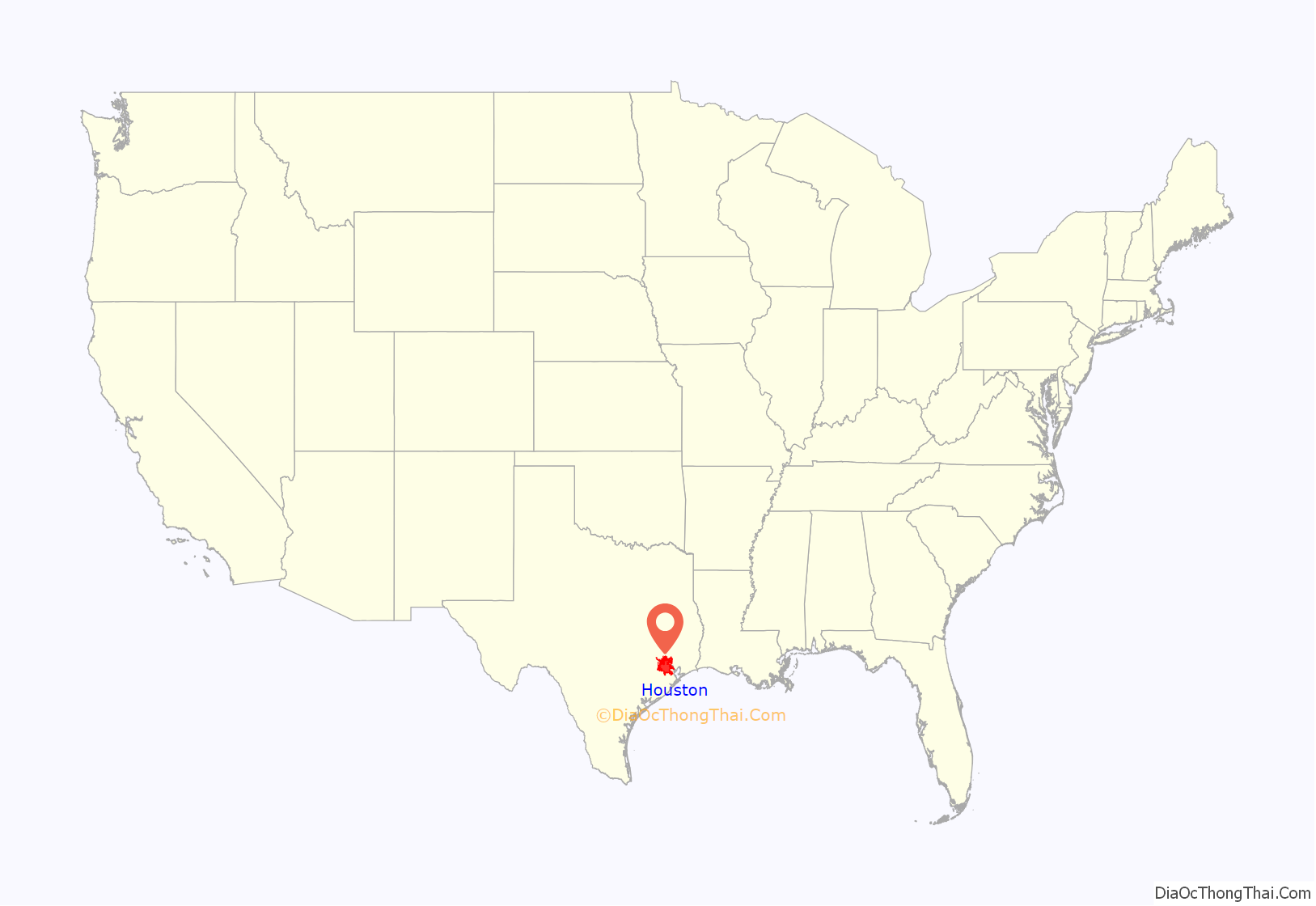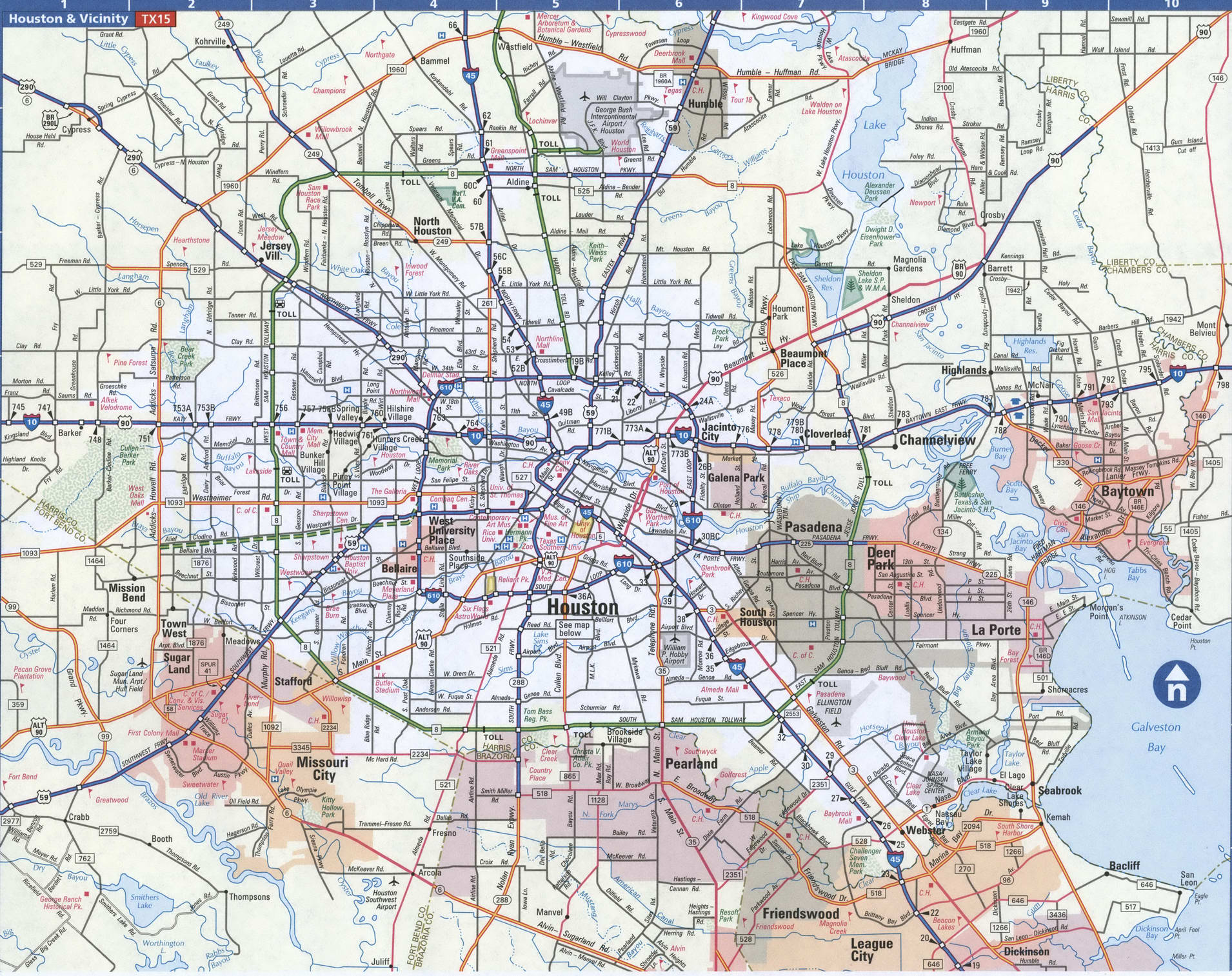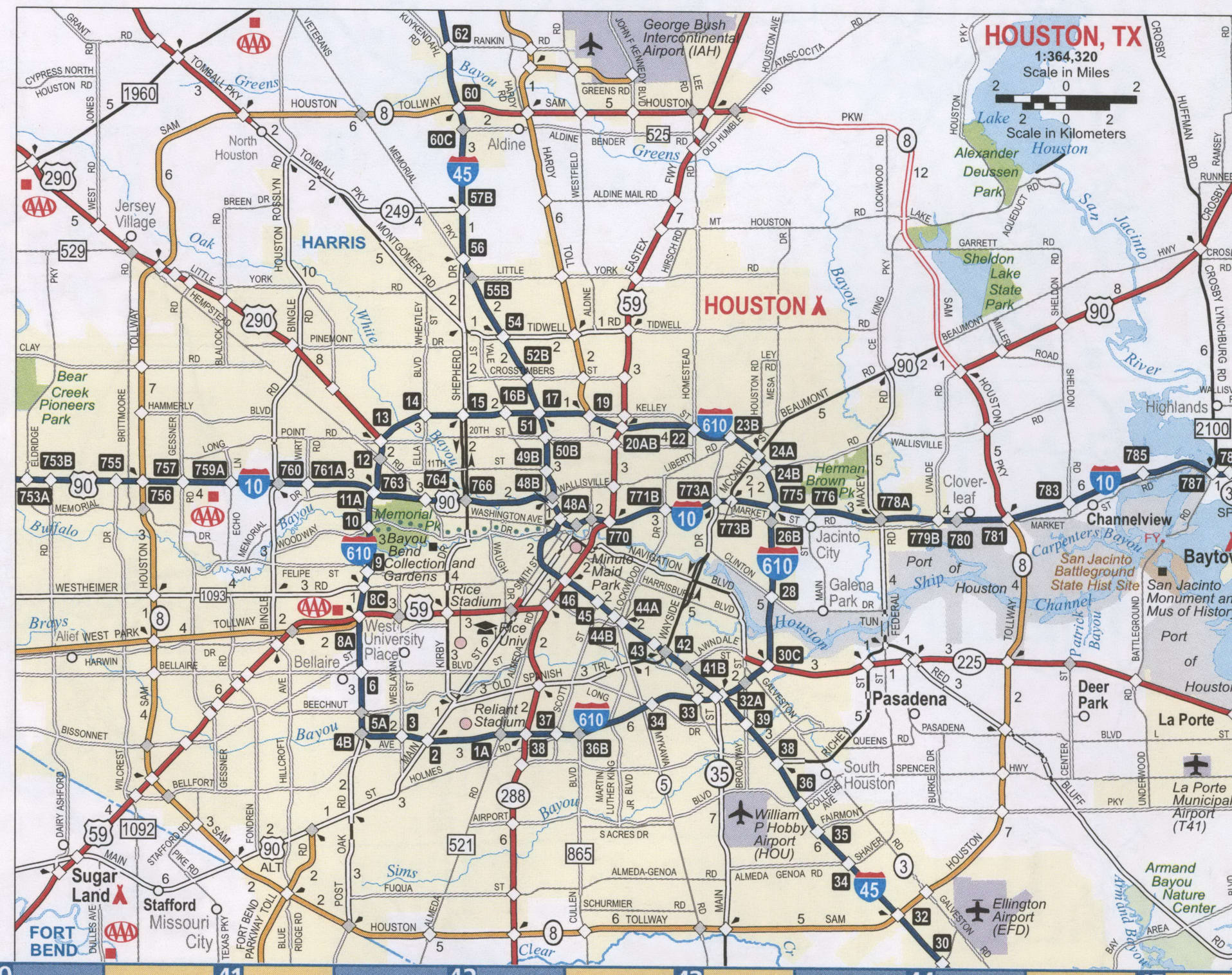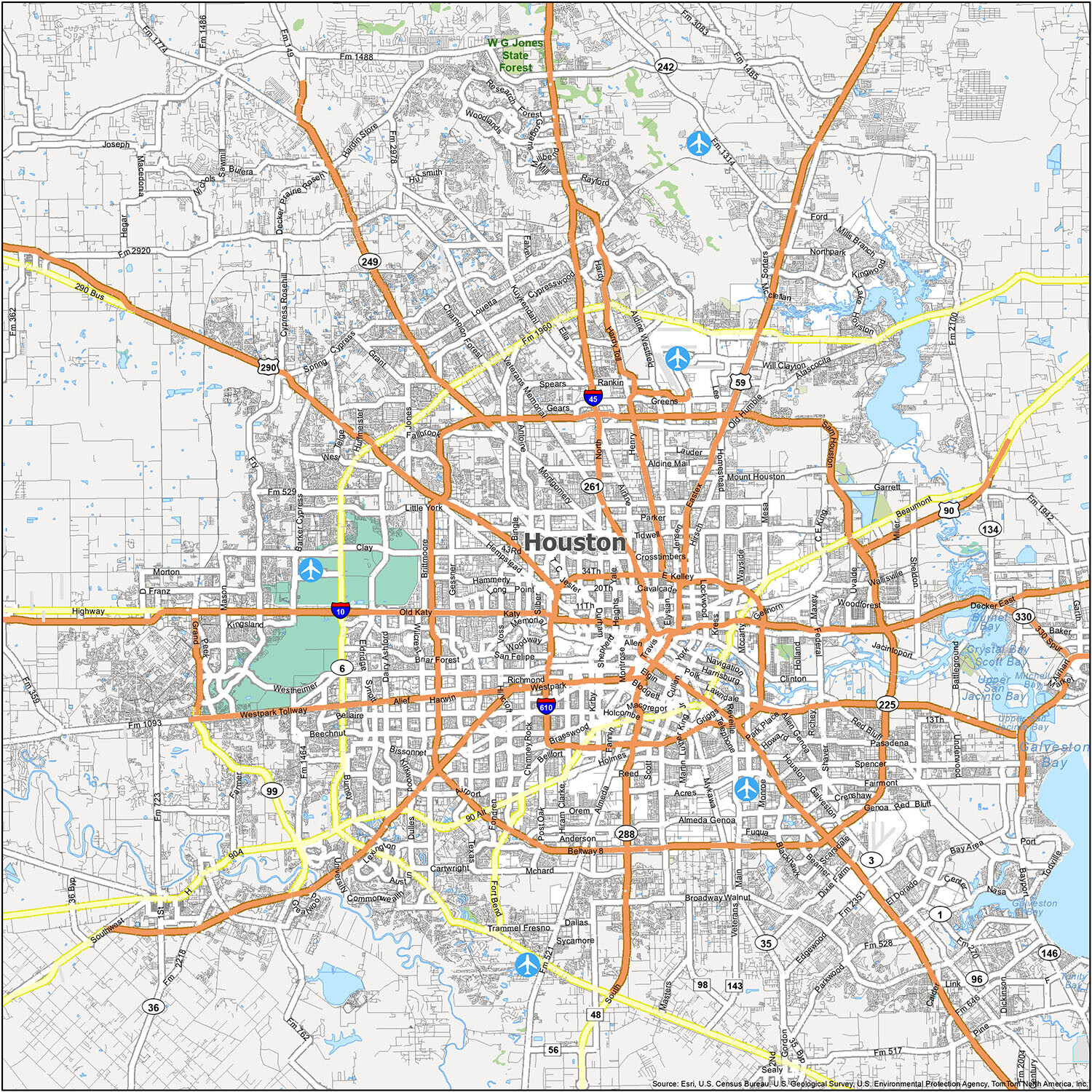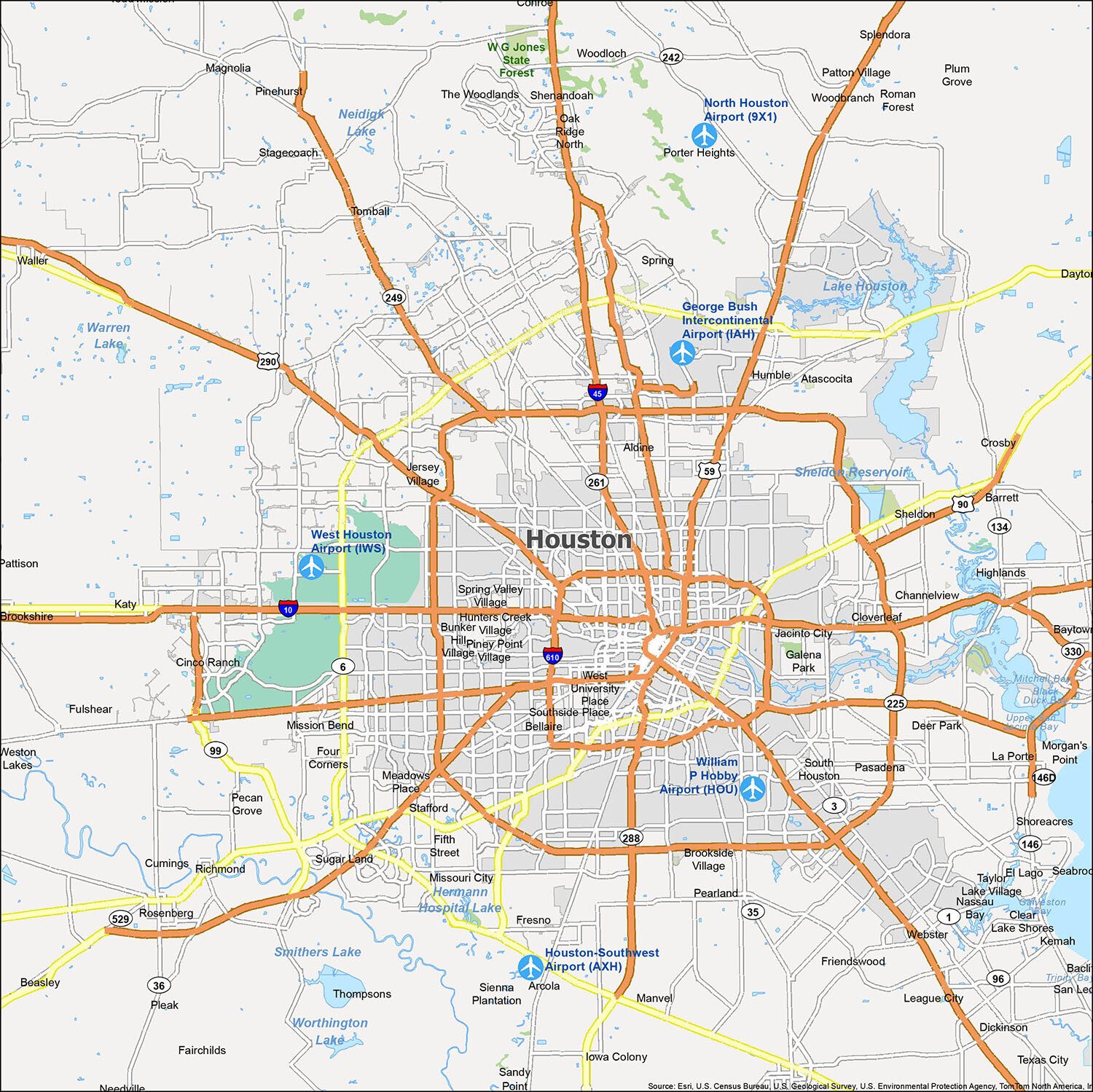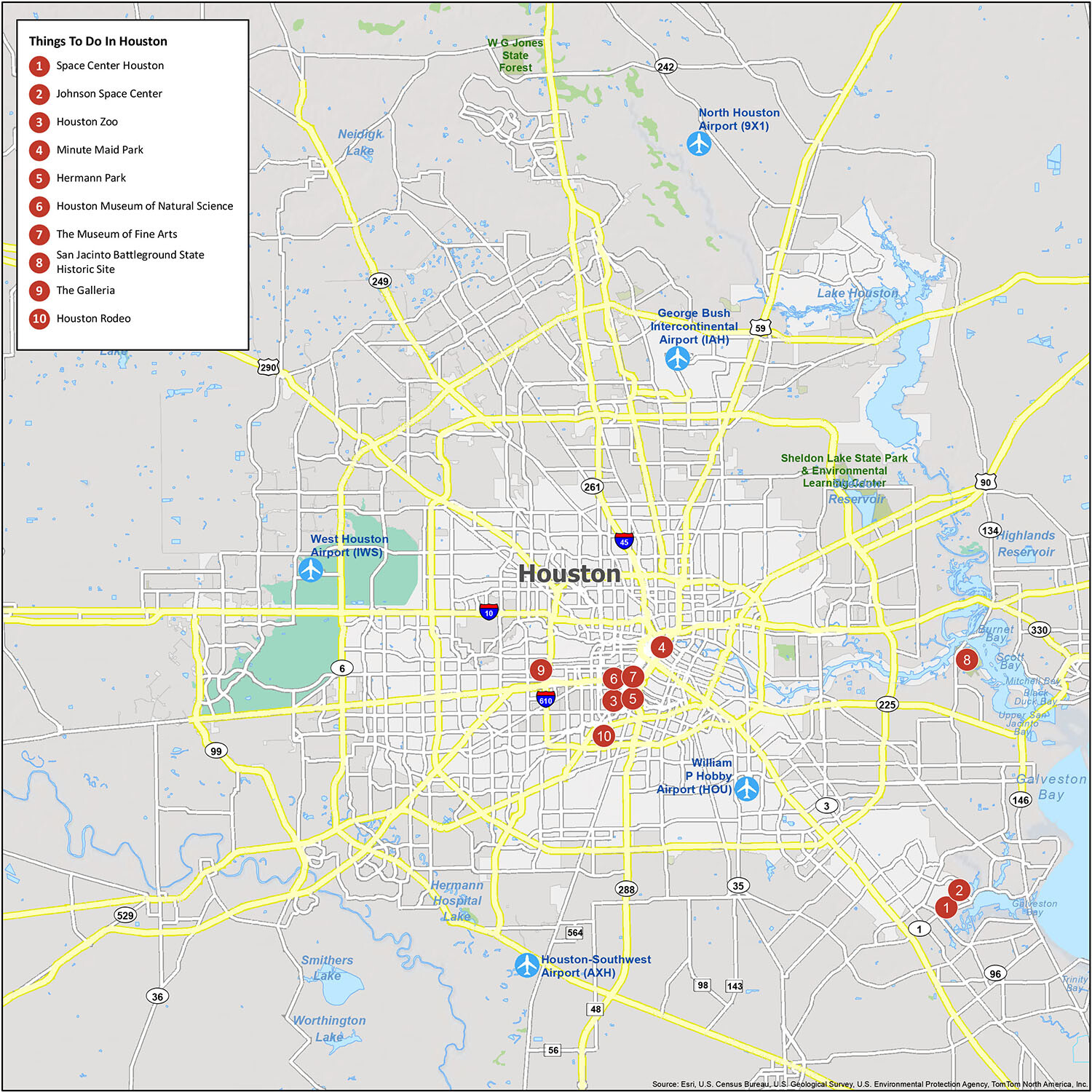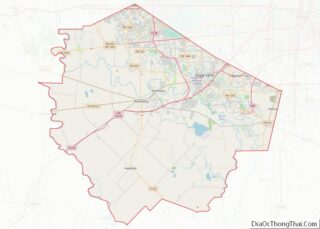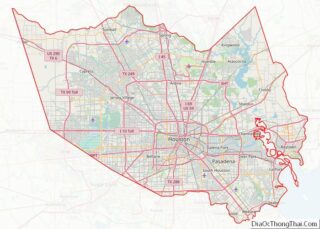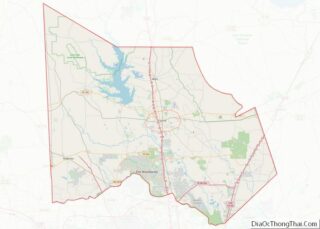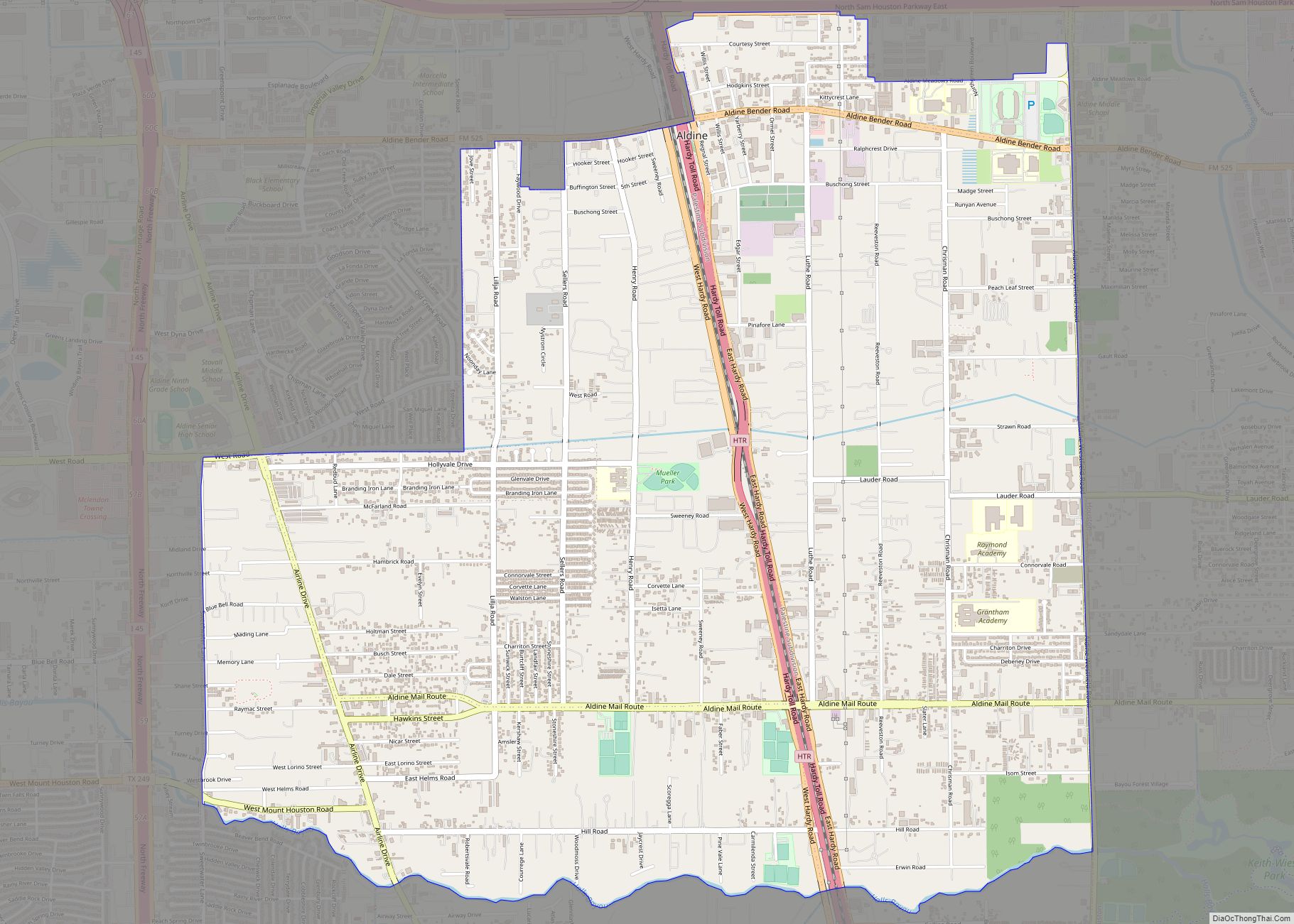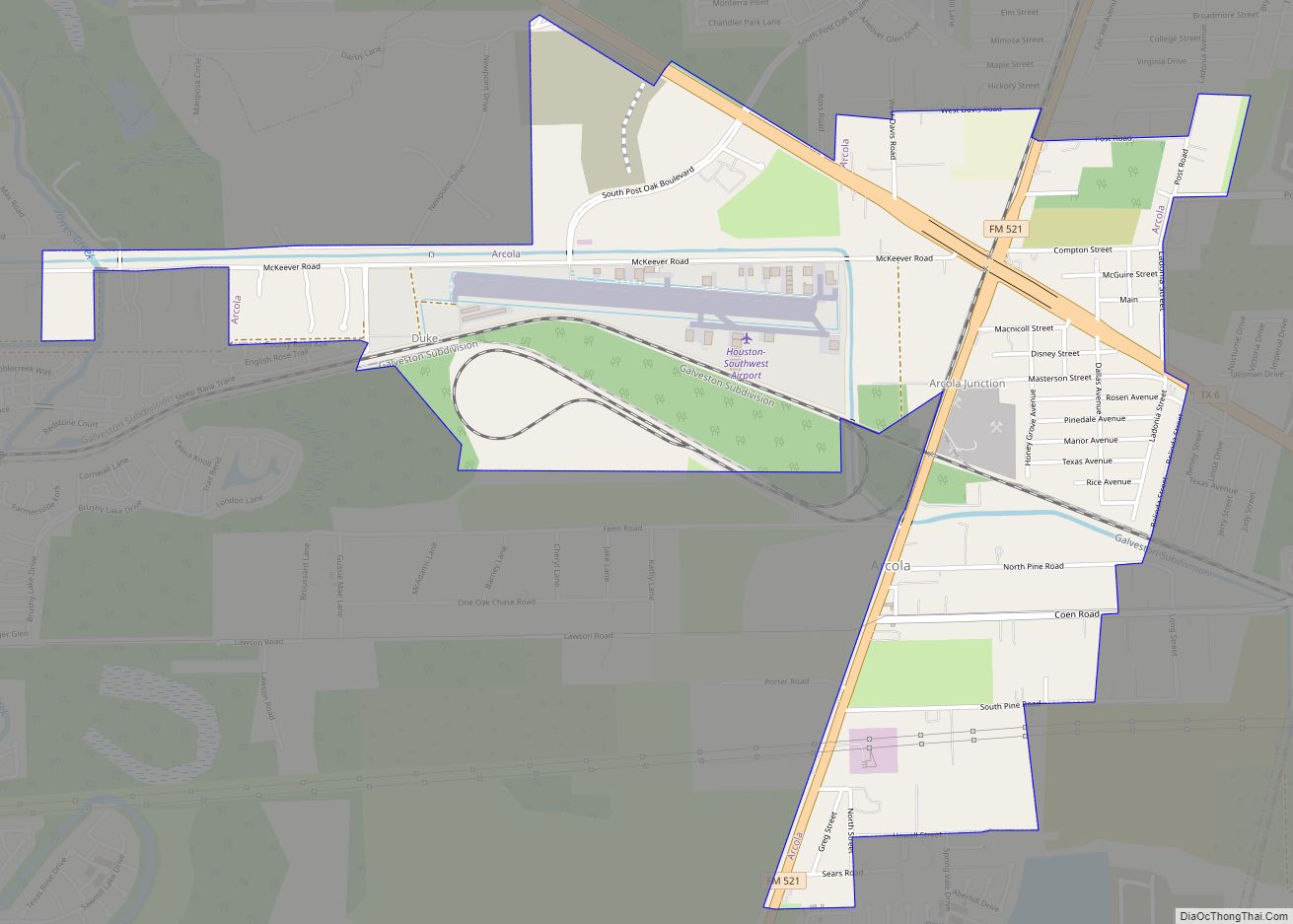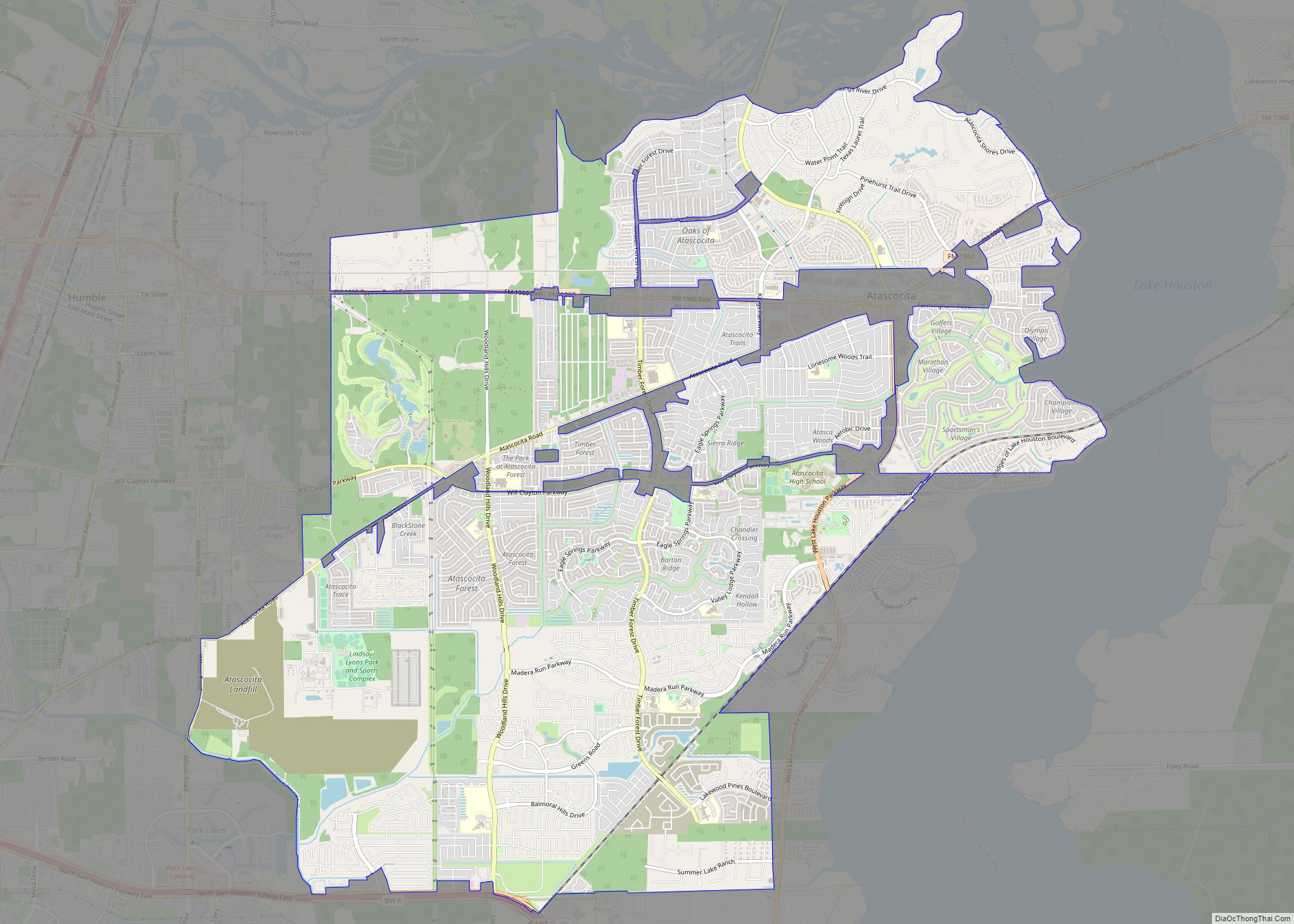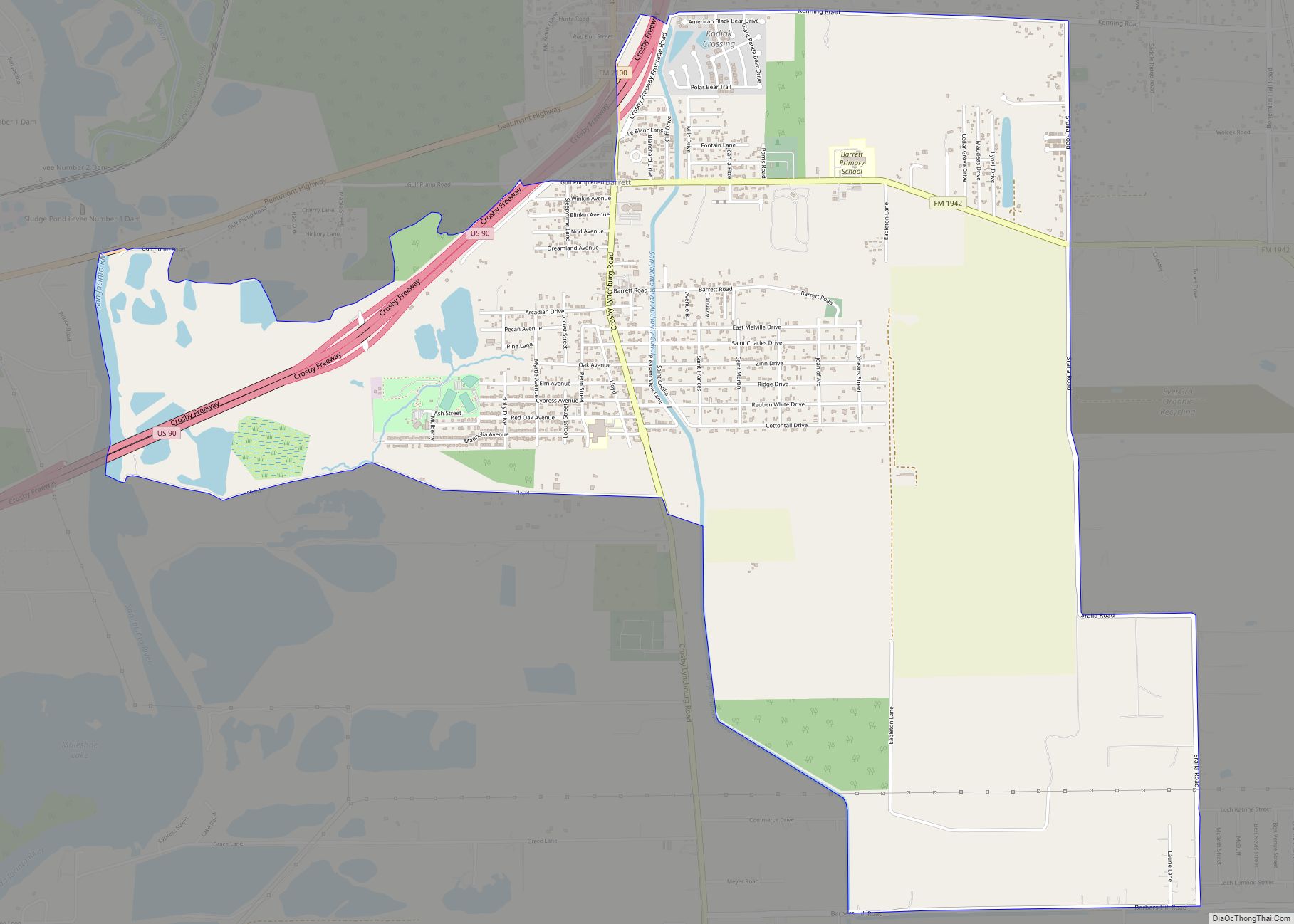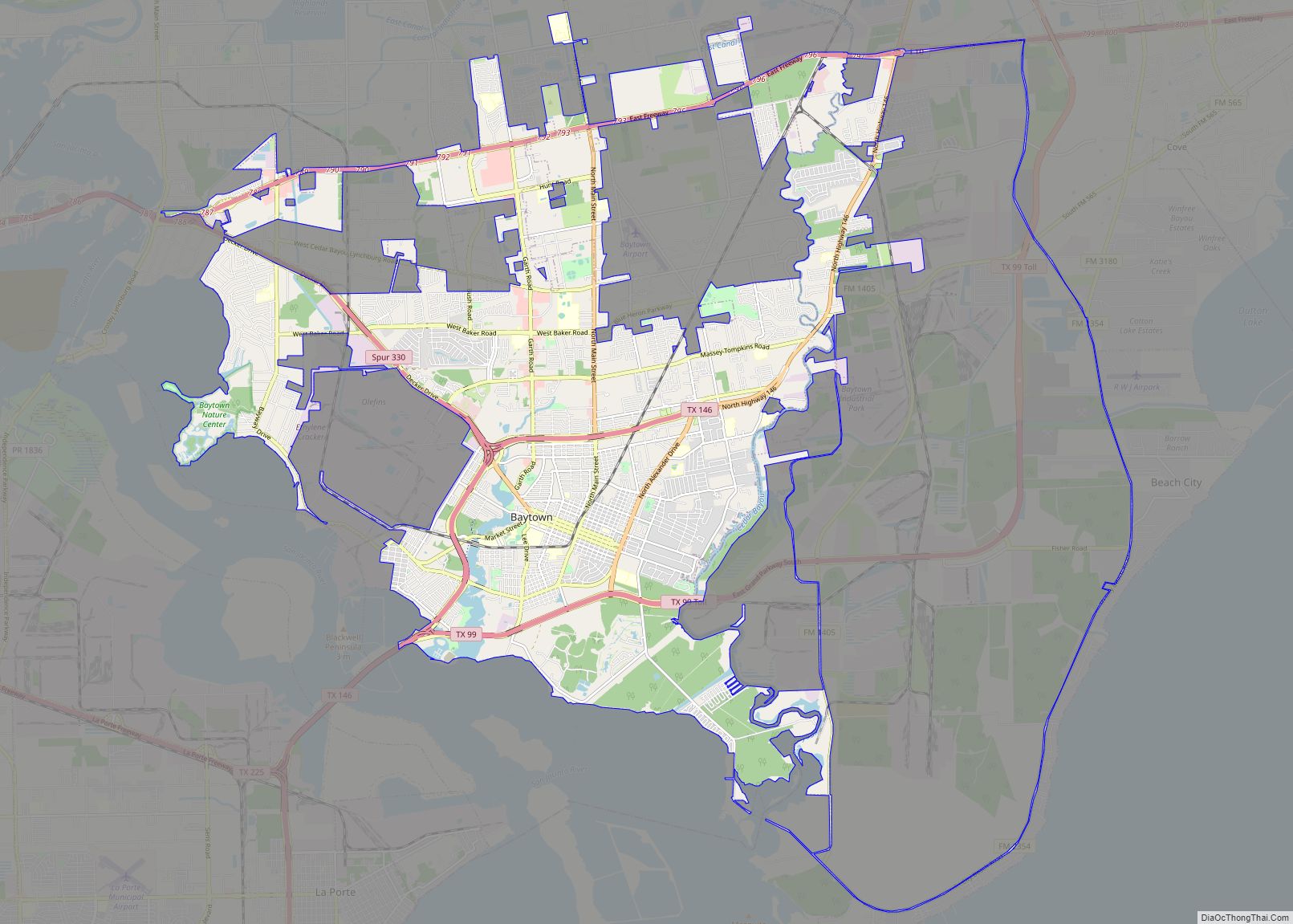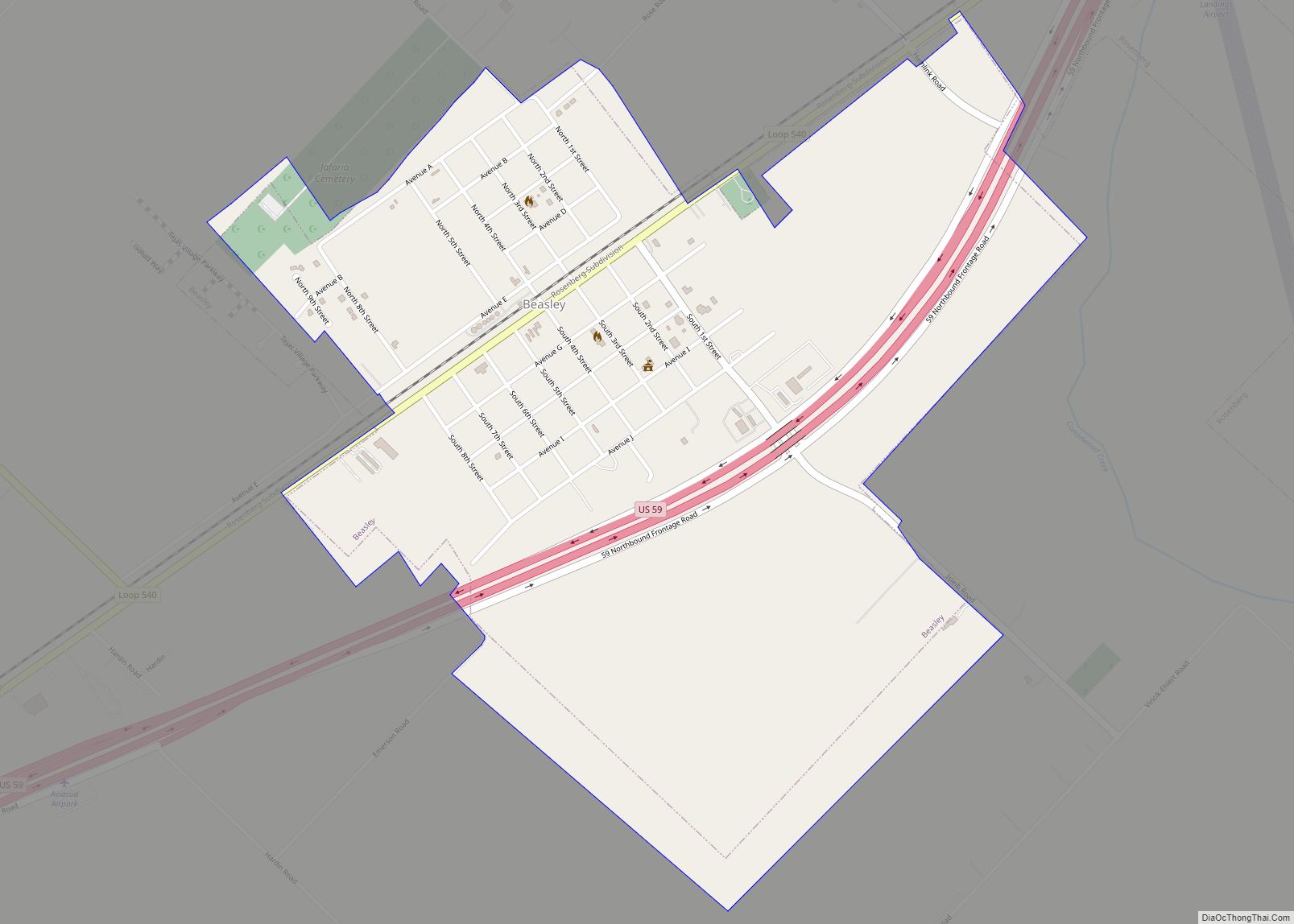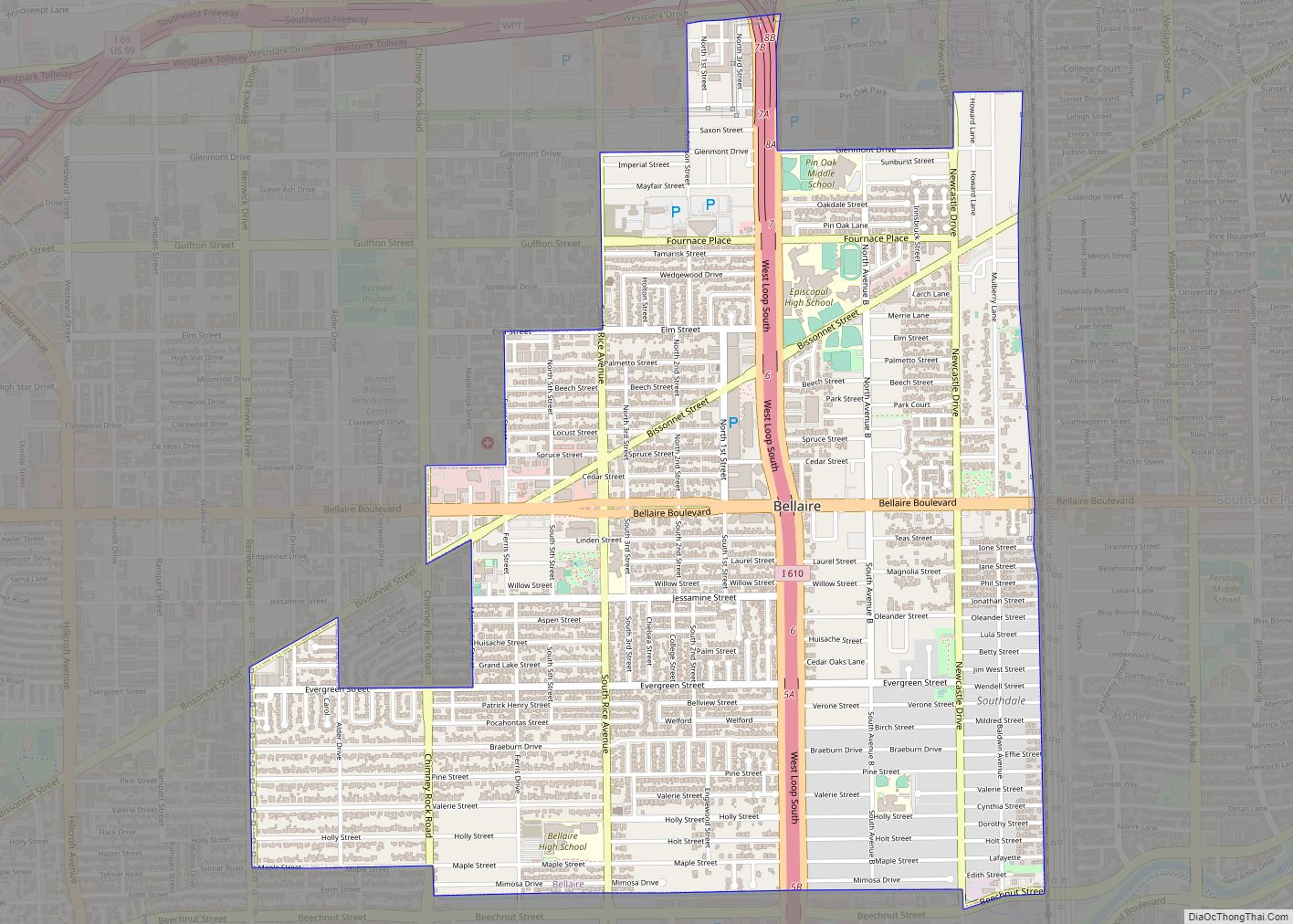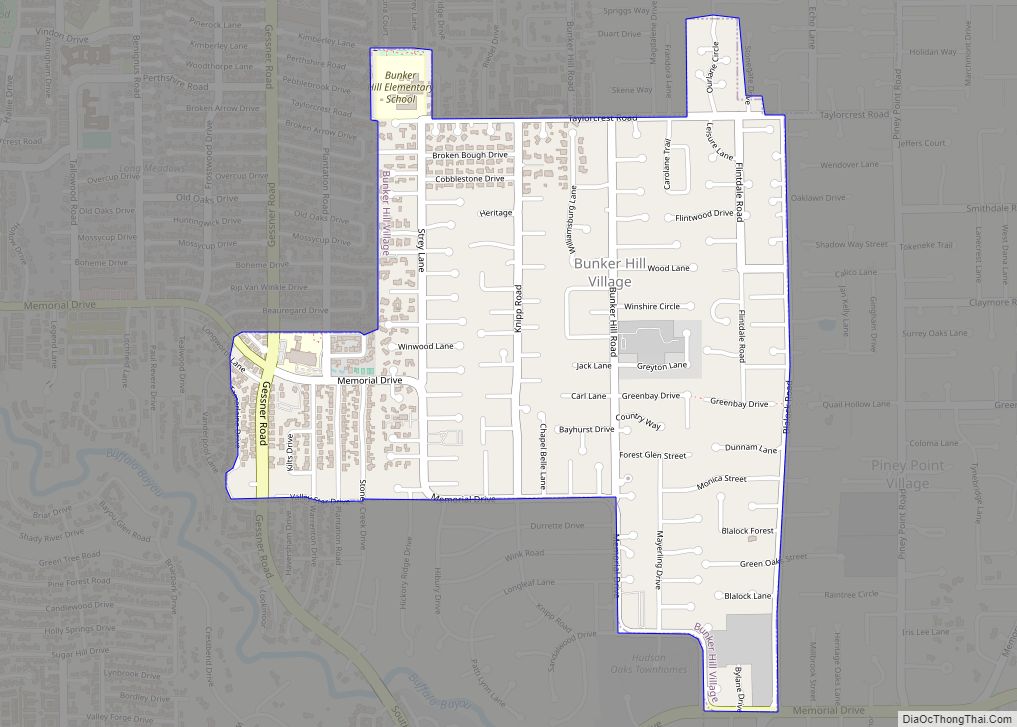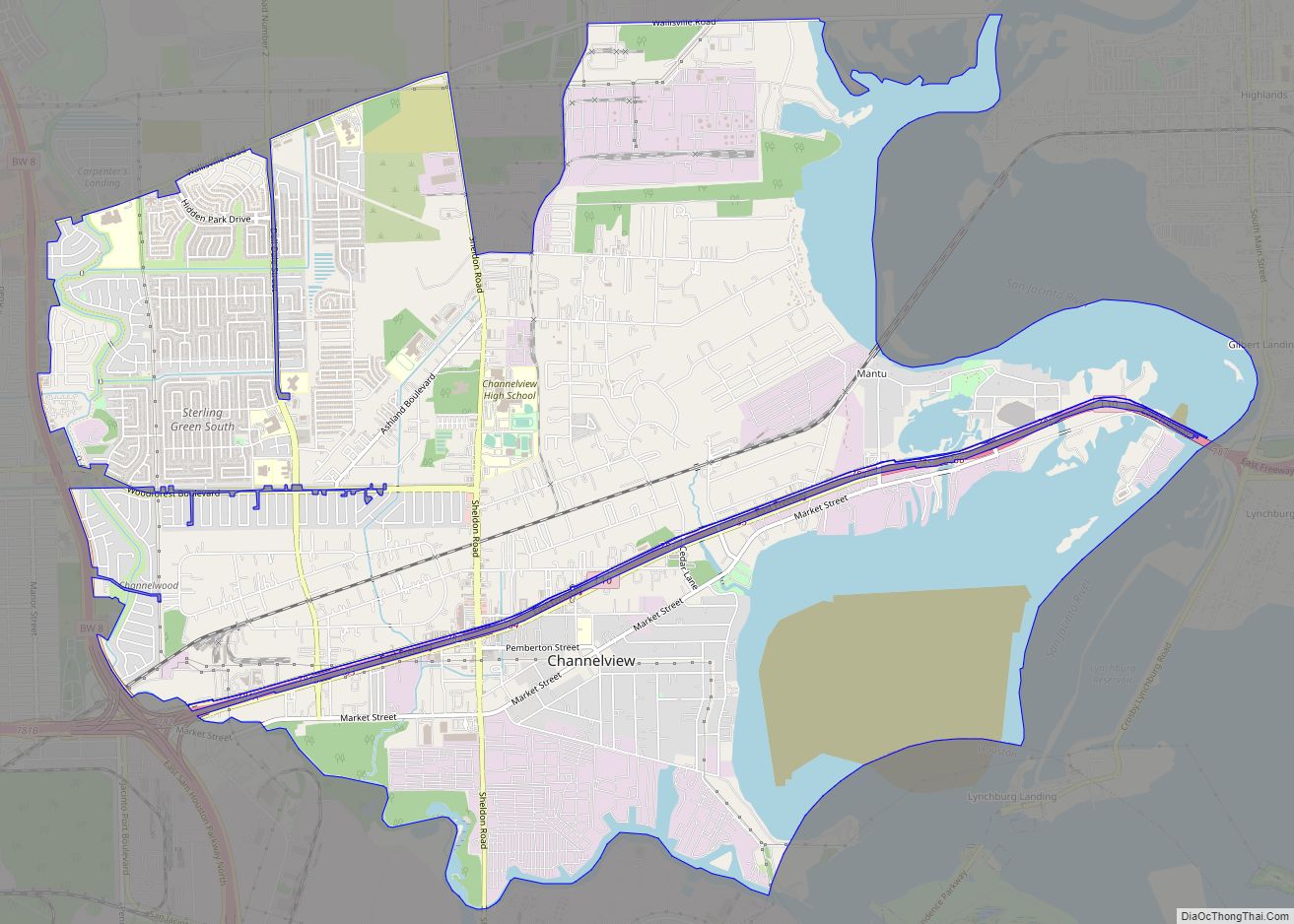Houston (/ˈhjuːstən/ (listen); HEW-stən) is the most populous city in Texas and in the Southern United States. It is the fourth-most populous city in the United States after New York City, Los Angeles, and Chicago, and the sixth-most populous city in North America. With a population of 2,304,580 in 2020, Houston is located in Southeast Texas near Galveston Bay and the Gulf of Mexico, it is the seat and largest city of Harris County and the principal city of the Greater Houston metropolitan area, which is the fifth-most populous metropolitan statistical area in the United States and the second-most populous in Texas after Dallas–Fort Worth. Houston is the southeast anchor of the greater megaregion known as the Texas Triangle.
Comprising a land area of 640.4 square miles (1,659 km), Houston is the ninth-most expansive city in the United States (including consolidated city-counties). It is the largest city in the United States by total area whose government is not consolidated with a county, parish, or borough. Though primarily in Harris County, small portions of the city extend into Fort Bend and Montgomery counties, bordering other principal communities of Greater Houston such as Sugar Land and The Woodlands.
Houston was founded by land investors on August 30, 1836, at the confluence of Buffalo Bayou and White Oak Bayou (a point now known as Allen’s Landing) and incorporated as a city on June 5, 1837. The city is named after former General Sam Houston, who was president of the Republic of Texas and had won Texas’s independence from Mexico at the Battle of San Jacinto 25 miles (40 km) east of Allen’s Landing. After briefly serving as the capital of the Texas Republic in the late 1830s, Houston grew steadily into a regional trading center for the remainder of the 19th century.
The arrival of the 20th century brought a convergence of economic factors that fueled rapid growth in Houston, including a burgeoning port and railroad industry, the decline of Galveston as Texas’s primary port following a devastating 1900 hurricane, the subsequent construction of the Houston Ship Channel, and the Texas oil boom. In the mid-20th century, Houston’s economy diversified, as it became home to the Texas Medical Center—the world’s largest concentration of healthcare and research institutions—and NASA’s Johnson Space Center, home to the Mission Control Center.
Since the late 19th century Houston’s economy has had a broad industrial base, in energy, manufacturing, aeronautics, and transportation. Leading in healthcare sectors and building oilfield equipment, Houston has the second-most Fortune 500 headquarters of any U.S. municipality within its city limits (after New York City). The Port of Houston ranks first in the United States in international waterborne tonnage handled and second in total cargo tonnage handled.
Nicknamed the “Bayou City”, “Space City”, “H-Town”, and “the 713”, Houston has become a global city, with strengths in culture, medicine, and research. The city has a population from various ethnic and religious backgrounds and a large and growing international community. Houston is the most diverse metropolitan area in Texas and has been described as the most racially and ethnically diverse major city in the U.S. It is home to many cultural institutions and exhibits, which attract more than seven million visitors a year to the Museum District. The Museum District is home to nineteen museums, galleries, and community spaces. Houston has an active visual and performing arts scene in the Theater District, and offers year-round resident companies in all major performing arts.
| Name: | Houston city |
|---|---|
| LSAD Code: | 25 |
| LSAD Description: | city (suffix) |
| State: | Texas |
| County: | Fort Bend County, Harris County, Montgomery County |
| Incorporated: | June 5, 1837 |
| Elevation: | 80 ft (32 m) |
| Land Area: | 640.44 sq mi (1,658.73 km²) |
| Water Area: | 31.23 sq mi (80.89 km²) |
| Population Density: | 3,598.43/sq mi (1,389.36/km²) |
| FIPS code: | 4835000 |
| GNISfeature ID: | 1380948 |
| Website: | www.houstontx.gov |
Discover the largest city in Texas and the fourth-largest in the United States with our Houston map. This map features roads/highways, reference information, and things to do. Plan your next adventure in Houston with our easy-to-use collection of printable maps. Whether you’re looking for superb attractions, exploring the city, or just want to know where you’re going, our map of Houston has you covered.
Online Interactive Map
Click on ![]() to view map in "full screen" mode.
to view map in "full screen" mode.
This is one of the only maps you’ll ever need to plan your trip to Houston, Texas. You can explore the city with this interactive map or use it to see what attractions are near you. With this map, you can explore the city and discover things to do, places to eat, and more. Get a better look at the city through this map and you can find out all there is to know about the city, while also having a better time exploring. Explore Houston and all the attractions and hot spots in the city with this one interactive map.
Houston location map. Where is Houston city?
History
The Houston area occupies land that was home of the Karankawa (kə rang′kə wä′,-wô′,-wə) and the Atakapa (əˈtɑːkəpə) indigenous peoples for at least 2,000 years before the first known settlers arrived. These tribes are almost nonexistent today; this was most likely caused by foreign disease, and competition with various settler groups in the 18th and 19th centuries. However, the land then remained largely uninhabited from the late 1700s until settlement in the 1830s.
Early settlement to the 20th century
The Allen brothers—Augustus Chapman and John Kirby—explored town sites on Buffalo Bayou and Galveston Bay. According to historian David McComb, “[T]he brothers, on August 26, 1836, bought from Elizabeth E. Parrott, wife of T.F.L. Parrott and widow of John Austin, the south half of the lower league [2,214-acre (896 ha) tract] granted to her by her late husband. They paid $5,000 total, but only $1,000 of this in cash; notes made up the remainder.”
The Allen brothers ran their first advertisement for Houston just four days later in the Telegraph and Texas Register, naming the notional town in honor of President Sam Houston. They successfully lobbied the Republic of Texas Congress to designate Houston as the temporary capital, agreeing to provide the new government with a state capitol building. About a dozen persons resided in the town at the beginning of 1837, but that number grew to about 1,500 by the time the Texas Congress convened in Houston for the first time that May. The Republic of Texas granted Houston incorporation on June 5, 1837, as James S. Holman became its first mayor. In the same year, Houston became the county seat of Harrisburg County (now Harris County).
In 1839, the Republic of Texas relocated its capital to Austin. The town suffered another setback that year when a yellow fever epidemic claimed about one life for every eight residents, yet it persisted as a commercial center, forming a symbiosis with its Gulf Coast port, Galveston. Landlocked farmers brought their produce to Houston, using Buffalo Bayou to gain access to Galveston and the Gulf of Mexico. Houston merchants profited from selling staples to farmers and shipping the farmers’ produce to Galveston.
The great majority of enslaved people in Texas came with their owners from the older slave states. Sizable numbers, however, came through the domestic slave trade. New Orleans was the center of this trade in the Deep South, but slave dealers were in Houston. Thousands of enslaved black people lived near the city before the American Civil War. Many of them near the city worked on sugar and cotton plantations, while most of those in the city limits had domestic and artisan jobs.
In 1840, the community established a chamber of commerce, in part to promote shipping and navigation at the newly created port on Buffalo Bayou.
By 1860, Houston had emerged as a commercial and railroad hub for the export of cotton. Railroad spurs from the Texas inland converged in Houston, where they met rail lines to the ports of Galveston and Beaumont. During the American Civil War, Houston served as a headquarters for Confederate Major General John B. Magruder, who used the city as an organization point for the Battle of Galveston. After the Civil War, Houston businessmen initiated efforts to widen the city’s extensive system of bayous so the city could accept more commerce between Downtown and the nearby port of Galveston. By 1890, Houston was the railroad center of Texas.
In 1900, after Galveston was struck by a devastating hurricane, efforts to make Houston into a viable deep-water port were accelerated. The following year, the discovery of oil at the Spindletop oil field near Beaumont prompted the development of the Texas petroleum industry. In 1902, President Theodore Roosevelt approved a $1 million improvement project for the Houston Ship Channel. By 1910, the city’s population had reached 78,800, almost doubling from a decade before. African Americans formed a large part of the city’s population, numbering 23,929 people, which was nearly one-third of Houston’s residents.
President Woodrow Wilson opened the deep-water Port of Houston in 1914, seven years after digging began. By 1930, Houston had become Texas’s most populous city and Harris County the most populous county. In 1940, the U.S. Census Bureau reported Houston’s population as 77.5% White and 22.4% Black.
World War II to the late 20th century
When World War II started, tonnage levels at the port decreased and shipping activities were suspended; however, the war did provide economic benefits for the city. Petrochemical refineries and manufacturing plants were constructed along the ship channel because of the demand for petroleum and synthetic rubber products by the defense industry during the war. Ellington Field, initially built during World War I, was revitalized as an advanced training center for bombardiers and navigators. The Brown Shipbuilding Company was founded in 1942 to build ships for the U.S. Navy during World War II. Due to the boom in defense jobs, thousands of new workers migrated to the city, both blacks, and whites competing for the higher-paying jobs. President Roosevelt had established a policy of nondiscrimination for defense contractors, and blacks gained some opportunities, especially in shipbuilding, although not without resistance from whites and increasing social tensions that erupted into occasional violence. Economic gains of blacks who entered defense industries continued in the postwar years.
In 1945, the M.D. Anderson Foundation formed the Texas Medical Center. After the war, Houston’s economy reverted to being primarily port-driven. In 1948, the city annexed several unincorporated areas, more than doubling its size. Houston proper began to spread across the region. In 1950, the availability of air conditioning provided impetus for many companies to relocate to Houston, where wages were lower than those in the North; this resulted in an economic boom and produced a key shift in the city’s economy toward the energy sector.
The increased production of the expanded shipbuilding industry during World War II spurred Houston’s growth, as did the establishment in 1961 of NASA’s “Manned Spacecraft Center” (renamed the Lyndon B. Johnson Space Center in 1973). This was the stimulus for the development of the city’s aerospace industry. The Astrodome, nicknamed the “Eighth Wonder of the World”, opened in 1965 as the world’s first indoor domed sports stadium.
During the late 1970s, Houston had a population boom as people from the Rust Belt states moved to Texas in large numbers. The new residents came for numerous employment opportunities in the petroleum industry, created as a result of the Arab oil embargo. With the increase in professional jobs, Houston has become a destination for many college-educated persons, most recently including African Americans in a reverse Great Migration from northern areas.
In 1997, Houstonians elected Lee P. Brown as the city’s first African American mayor.
Early 21st century
Houston has continued to grow into the 21st century, with the population increasing 17% from 2000 to 2019.
Oil & gas have continued to fuel Houston’s economic growth, with major oil companies including Phillips 66, ConocoPhillips, Occidental Petroleum, Halliburton, and ExxonMobil having their headquarters in the Houston area. In 2001, Enron Corporation, a Houston company with $100 billion in revenue, became engulfed in an accounting scandal which bankrupted the company in 2001. Health care has emerged as a major industry in Houston. The Texas Medical Center is now the largest medical complex in the world and employs 106,000 people.
Three new sports stadiums opened downtown in the first decade of the 21st century. In 2000, the Houston Astros opened their new baseball stadium, Minute Maid Park, in downtown adjacent to the old Union Station. The Houston Texans were formed in 2002 as an NFL expansion team, replacing the Houston Oilers, which had left the city in 1996. NRG Stadium opened the same year. In 2003, the Toyota Center opened as the home for the Houston Rockets. In 2005, the Houston Dynamo soccer team was formed. In 2017, the Houston Astros won their first World Series.
Flooding has been a recurring problem in the Houston area, exacerbated by a lack of zoning laws, which allowed unregulated building of residential homes and other structures in flood-prone areas. In June 2001, Tropical Storm Allison dumped up to 40 inches (1,000 mm) of rain on parts of Houston, causing what was then the worst flooding in the city’s history and billions of dollars in damage, and killed 20 people in Texas. In August 2005, Houston became a shelter to more than 150,000 people from New Orleans, who evacuated from Hurricane Katrina. One month later, about 2.5 million Houston-area residents evacuated when Hurricane Rita approached the Gulf Coast, leaving little damage to the Houston area. This was the largest urban evacuation in the history of the United States. In May 2015, seven people died after 12 inches of rain fell in 10 hours during what is known as the Memorial Day Flood. Eight people died in April 2016 during a storm that dropped 17 inches of rain. The worst came in late August 2017, when Hurricane Harvey stalled over southeastern Texas, much like Tropical Storm Allison did sixteen years earlier, causing severe flooding in the Houston area, with some areas receiving over 50 inches (1,300 mm) of rain. The rainfall exceeded 50 inches in several areas locally, breaking the national record for rainfall. The damage for the Houston area was estimated at up to $125 billion U.S. dollars, and was considered to be one of the worst natural disasters in the history of the United States, with the death toll exceeding 70 people.
Houston Road Map
Houston is a bustling city and it can be intimidating to navigate. But with this Houston road map, you can easily find your way around the city. This printable map includes major interstates, highways, and roads, so you can easily get to where you need to go. Don’t let the hustle and bustle of the city get you lost. Use this map to help you find your way around the city of Houston and make the most of your time. For travel outside the city, take a look at our Texas road map that’s also available for free.
Exploring Houston is a great way to experience the city and its many attractions. With this reference map, you can find out about the airports, towns, villages, and cities that make up Houston, Texas. Discover some of the most interesting and beautiful places in the area and plan your next adventure. From parks to villages and things to do and see, you can use this map to explore Houston, Texas.
10 things to do in Houston city
Explore Houston with this easy-to-use map! Whether you’re here for a day or a weekend, you’ll find something to do. From the Space Center Houston to the Houston Zoo, there are plenty of attractions to keep you occupied. With this map, you’ll be able to find the best places to visit and the hidden gems that are waiting to be discovered.
Make the most of your visit to Houston with this convenient and easy-to-use map. Discover the best of Houston and find your way around with ease. With this map, you’ll be able to explore the city and find hidden gems. So, don’t miss out on the great attractions Houston has to offer and start planning your next trip to the Lone Star State!
Houston city Satellite Map
See also
Map of Texas State and its subdivision:- Anderson
- Andrews
- Angelina
- Aransas
- Archer
- Armstrong
- Atascosa
- Austin
- Bailey
- Bandera
- Bastrop
- Baylor
- Bee
- Bell
- Bexar
- Blanco
- Borden
- Bosque
- Bowie
- Brazoria
- Brazos
- Brewster
- Briscoe
- Brooks
- Brown
- Burleson
- Burnet
- Caldwell
- Calhoun
- Callahan
- Cameron
- Camp
- Carson
- Cass
- Castro
- Chambers
- Cherokee
- Childress
- Clay
- Cochran
- Coke
- Coleman
- Collin
- Collingsworth
- Colorado
- Comal
- Comanche
- Concho
- Cooke
- Coryell
- Cottle
- Crane
- Crockett
- Crosby
- Culberson
- Dallam
- Dallas
- Dawson
- Deaf Smith
- Delta
- Denton
- Dewitt
- Dickens
- Dimmit
- Donley
- Duval
- Eastland
- Ector
- Edwards
- El Paso
- Ellis
- Erath
- Falls
- Fannin
- Fayette
- Fisher
- Floyd
- Foard
- Fort Bend
- Franklin
- Freestone
- Frio
- Gaines
- Galveston
- Garza
- Gillespie
- Glasscock
- Goliad
- Gonzales
- Gray
- Grayson
- Gregg
- Grimes
- Guadalupe
- Hale
- Hall
- Hamilton
- Hansford
- Hardeman
- Hardin
- Harris
- Harrison
- Hartley
- Haskell
- Hays
- Hemphill
- Henderson
- Hidalgo
- Hill
- Hockley
- Hood
- Hopkins
- Houston
- Howard
- Hudspeth
- Hunt
- Hutchinson
- Irion
- Jack
- Jackson
- Jasper
- Jeff Davis
- Jefferson
- Jim Hogg
- Jim Wells
- Johnson
- Jones
- Karnes
- Kaufman
- Kendall
- Kenedy
- Kent
- Kerr
- Kimble
- King
- Kinney
- Kleberg
- Knox
- La Salle
- Lamar
- Lamb
- Lampasas
- Lavaca
- Lee
- Leon
- Liberty
- Limestone
- Lipscomb
- Live Oak
- Llano
- Loving
- Lubbock
- Lynn
- Madison
- Marion
- Martin
- Mason
- Matagorda
- Maverick
- McCulloch
- McLennan
- McMullen
- Medina
- Menard
- Midland
- Milam
- Mills
- Mitchell
- Montague
- Montgomery
- Moore
- Morris
- Motley
- Nacogdoches
- Navarro
- Newton
- Nolan
- Nueces
- Ochiltree
- Oldham
- Orange
- Palo Pinto
- Panola
- Parker
- Parmer
- Pecos
- Polk
- Potter
- Presidio
- Rains
- Randall
- Reagan
- Real
- Red River
- Reeves
- Refugio
- Roberts
- Robertson
- Rockwall
- Runnels
- Rusk
- Sabine
- San Augustine
- San Jacinto
- San Patricio
- San Saba
- Schleicher
- Scurry
- Shackelford
- Shelby
- Sherman
- Smith
- Somervell
- Starr
- Stephens
- Sterling
- Stonewall
- Sutton
- Swisher
- Tarrant
- Taylor
- Terrell
- Terry
- Throckmorton
- Titus
- Tom Green
- Travis
- Trinity
- Tyler
- Upshur
- Upton
- Uvalde
- Val Verde
- Van Zandt
- Victoria
- Walker
- Waller
- Ward
- Washington
- Webb
- Wharton
- Wheeler
- Wichita
- Wilbarger
- Willacy
- Williamson
- Wilson
- Winkler
- Wise
- Wood
- Yoakum
- Young
- Zapata
- Zavala
- Alabama
- Alaska
- Arizona
- Arkansas
- California
- Colorado
- Connecticut
- Delaware
- District of Columbia
- Florida
- Georgia
- Hawaii
- Idaho
- Illinois
- Indiana
- Iowa
- Kansas
- Kentucky
- Louisiana
- Maine
- Maryland
- Massachusetts
- Michigan
- Minnesota
- Mississippi
- Missouri
- Montana
- Nebraska
- Nevada
- New Hampshire
- New Jersey
- New Mexico
- New York
- North Carolina
- North Dakota
- Ohio
- Oklahoma
- Oregon
- Pennsylvania
- Rhode Island
- South Carolina
- South Dakota
- Tennessee
- Texas
- Utah
- Vermont
- Virginia
- Washington
- West Virginia
- Wisconsin
- Wyoming
